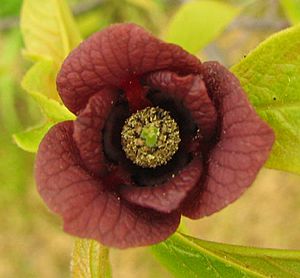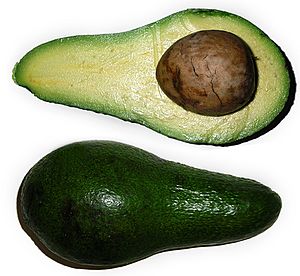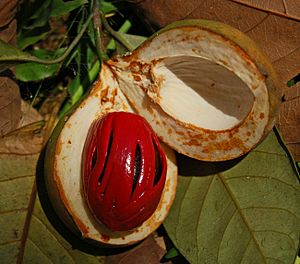Magnoliids facts for kids
Quick facts for kids Magnoliids |
|
|---|---|
 |
|
| Flower of Asimina triloba | |
| Scientific classification |
|
| Kingdom: | Plantae |
| Clade: | Tracheophytes |
| Clade: | Angiosperms |
| Clade: | Magnoliids |
| Type species | |
| Magnolia virginiana |
|
| Orders | |
|
Canellales |
|
Magnoliids, Magnoliidae or Magnolianae are a clade of flowering plants. With more than 10,000 species, including magnolias, nutmeg, bay laurel, cinnamon, avocado, black pepper, tulip tree and many others, it is the third-largest group of angiosperms after the eudicots and monocots. The group is characterized by trimerous flowers, pollen with one pore, and usually branching-veined leaves.
Some members of the subclass are among the earliest angiosperms and share anatomical similarities with gymnosperms like stamens that resemble the male cone scales of conifers and carpels found on the long flowering axis.
Economic use
The magnoliids is a large group of plants, with many species that are economically important as food, drugs, perfumes, timber, and as ornamentals, among many other uses.

One widely cultivated magnoliid fruit is the avocado (Persea americana), which is believed to have been cultivated in Mexico and Central America for nearly 10,000 years. Now grown throughout the tropics, it probably originates from the Chiapas region of Mexico or Guatemala, where "wild" avocados may still be found. The soft pulp of the fruit is eaten fresh or mashed into guacamole. The ancient peoples of Central America were also the first to cultivate several fruit-bearing species of Annona. These include the custard-apple (A. reticulata), soursop (A. muricata), sweetsop or sugar-apple (A. squamosa), and the cherimoya (A. cherimola). Both soursop and sweetsop now are widely grown for their fruits in the Old World as well.
Some members of the magnoliids have served as important food additives, such as black pepper, nutmeg, bay laurel and cinnamon. Oil of sassafras was formerly used as a key flavoring in both root beer and in sarsaparilla. The primary ingredient responsible for the oil's flavor is safrole, but it is no longer used in either the United States or Canada. Both nations banned the use of safrole as a food additive in 1960 as a result of studies that demonstrated safrole promoted liver damage and tumors in mice. Consumption of more than a minute quantity of the oil causes nausea, vomiting, hallucinations, and shallow rapid breathing. It is very toxic, and can severely damage the kidneys.

Other magnoliids also are known for their paralytic properties. The Polynesian beverage kava is prepared from the pulverized roots of Piper methysticum, and has sedative properties. It is used throughout the Pacific in social gatherings or after work to relax. Another phsycoactive compound comes from the spice nutmeg. Ingestion of nutmeg in quantities can lead to hallucinations, nausea, and vomiting, with symptoms lasting several days. A more severe reaction comes from poisoning by rodiasine and demethylrodiasine, the active ingredients in fruit extract from Chlorocardium venenosum. These chemicals paralyze muscles and nerves, resulting in tetanus-like reactions in animals. The Cofán peoples of westernmost Amazon in Colombia and Ecuador use the compound as a poison to tip their arrows in hunting.
Not all the effects of chemical compounds in the magnoliids are detrimental. In previous centuries, sailors would use Winter's Bark from the South American tree Drimys winteri to ward off the vitamin-deficiency of scurvy. Today, benzoyl is extracted from Lindera benzoin (common spicebush) for use as a food additive and skin medicine, due to its anti-bacterial and anti-fungal properties. Drugs extracted from the bark of Magnolia have long been used in traditional Chinese medicine. Scientific investigation of magnolol and honokiol have shown promise for their use in dental health. Both compounds demonstrate effective anti-bacterial activity against the bacteria responsible for bad breath and dental caries. Several members of the family Annonaceae are also under investigation for uses of a group of chemicals called acetogenins. The first acetogenin discovered was uvaricin, which has anti-leukemic properties when used in living organisms. Other acetogenins have been discovered with anti-malarial and anti-tumor properties, and some even inhibit HIV replication in laboratory studies.
Many magnoliid species produce essential oils in their leaves, bark, or wood. The tree Virola surinamensis (Brazilian "nutmeg") contains trimyristin, which is extracted in the form of a fat and used in soaps and candles, as well as in shortenings. Other fragrant volatile oils are extracted from Aniba rosaeodora (bois-de-rose oil), Cinnamomum porrectum, Cinnamomum cassia, and Litsea odorifera for scenting soaps. Perfumes also are made from some of these oils; ylang-ylang comes from the flowers of Cananga odorata, and is used by Arab and Swahili women. A compound called nutmeg butter is produced from the same tree as the spice of that name, but the sweet-smelling "butter" is used in perfumery or as a lubricant rather than as a food.
See also

